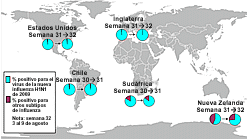Content on this page was developed during the 2009-2010 H1N1 pandemic and has not been updated.
- The H1N1 virus that caused that pandemic is now a regular human flu virus and continues to circulate seasonally worldwide.
- The English language content on this website is being archived for historic and reference purposes only.
- For current, updated information on seasonal flu, including information about H1N1, see the CDC Seasonal Flu website.
Novel 2009-H1N1 Flu: International Situation Update
August 14, 2009, 11:00 AM ET
This situation report provides an update to the international situation as of August 14, 2009. World Health Organization (WHO) regions have reported 177,457 laboratory-confirmed cases of novel 2009-H1N1 influenza virus (new H1N1) with 1,462 deaths. The laboratory-confirmed cases represent an underestimation of total cases in the world as many countries have shifted to strategies of clinical confirmation and prioritization of laboratory testing for only persons with severe illness and/or high risk conditions. The new H1N1 influenza virus is the dominant influenza virus in circulation in the world. According to a WHO Global Influenza Surveillance Network (GISN) report dated August 4th, 71% of all influenza viruses currently detected globally are the new H1N1. The new H1N1 accounts for 66% of influenza viruses in the Northern Hemisphere and 89% of influenza viruses in the Southern Hemisphere. There are indications that disease may be decreasing in South America and part of Australia. Disease associated with new H1N1 influenza is continuing to increase in southern Africa.
Selected Highlights
- The new H1N1 influenza virus is the predominate influenza virus in circulation worldwide.
- The epidemiology of the disease caused by the novel 2009-H1N1 influenza virus in the Southern Hemisphere is very similar to that described in the United States this past spring.
- Isolates sequenced at WHO and CDC suggest that circulating novel 2009-H1N1 influenza viruses look similar to A/California/07/2009 (the reference virus selected by WHO as a potential candidate for the new H1N1 vaccine).
International Resources for Novel H1N1 Information
Health Organizations
- World Health Organization (WHO)
- ECDC (European Centre for Disease Prevention and Control)
- H2P (Humanitarian Pandemic Preparedness)
- Public Health Agency of Canada
World Health Organization (WHO) Regional Offices
- AFRO (WHO Regional Office for Africa)
- AMRO (WHO Regional Office for the Americas) / PAHO (Pan American Health Organization)
- EMRO (WHO Regional Office for the Eastern Mediterranean)
- EURO (WHO Regional Office for Europe)
- SEARO (WHO Regional Office for South-East Asia)
- WPRO (WHO Regional Office for the Western Pacific)
Travel and Novel H1N1 Flu
Human cases of novel H1N1 flu virus infection have been identified in the United States and several countries around the world. For information on novel H1N1 flu and travel, see the CDC H1N1 Flu and Travel website.
Reports and Publications
- ECDC Interim Risk Assessment Influenza A (H1N1) 2009 Pandemic
Issued July 30, 2009 - This document provides an interim risk assessment of novel H1N1 flu in Europe prepared by ECDC. - World Health Organization Weekly Epidemiological record – Issued July 24, 2009
This document by WHO provides updates on the international novel H1N1 flu situation. - MMWR – Update: Novel Influenza A (H1N1) Virus Infection – Mexico, March-May, 2009 – Issued June 5, 2009 / Vol. 58 / No. 21.
This Morbidity and Mortality Weekly Report describes the novel influenza A (H1N1) outbreak in Mexico from March-May, 2009. - MMWR – Update: Novel Influenza A (H1N1) Virus Infections – Worldwide, May 6, 2009 – Issued May 8, 2009 / Vol. 58 / No. 17.
This Morbidity and Mortality Weekly Report describes worldwide novel influenza A (H1N1) infections as of May 6, 2009.
Get email updates
To receive weekly email updates about this site, enter your email address:
Contact Us:
- Centers for Disease Control and Prevention
1600 Clifton Rd
Atlanta, GA 30333 - 800-CDC-INFO
(800-232-4636)
TTY: (888) 232-6348 - Contact CDC-INFO



